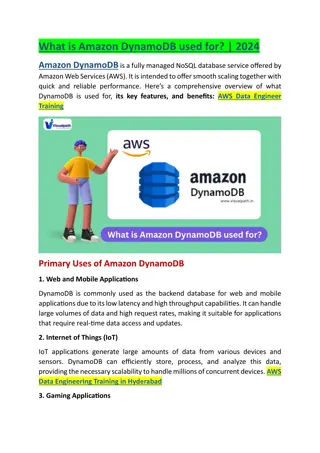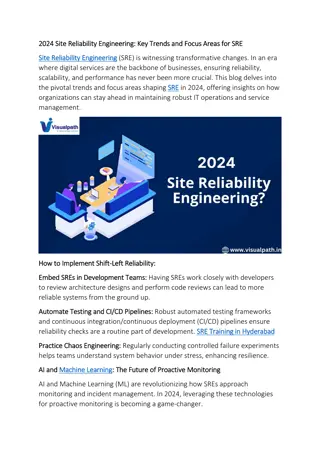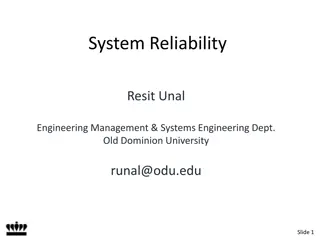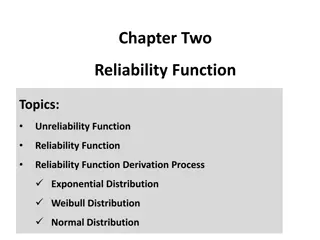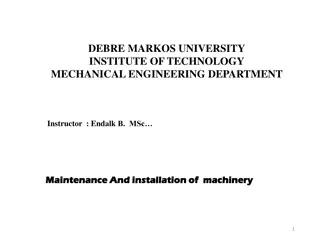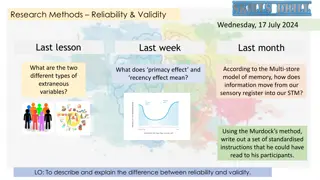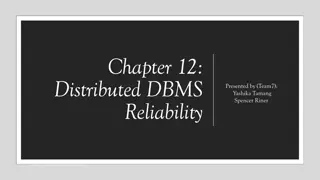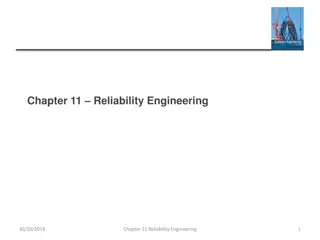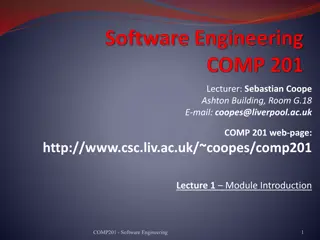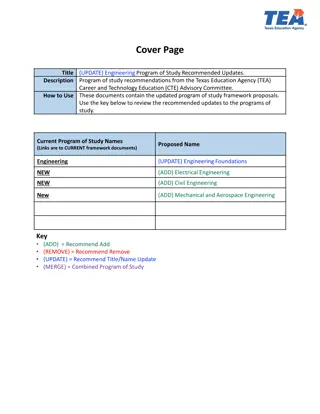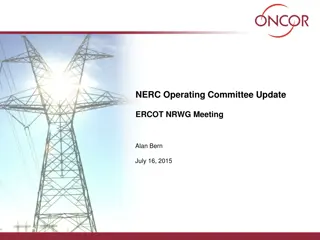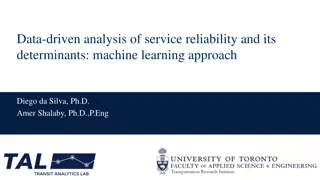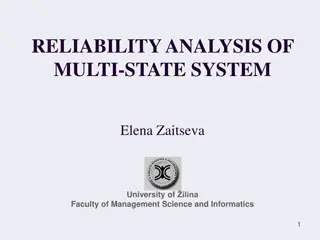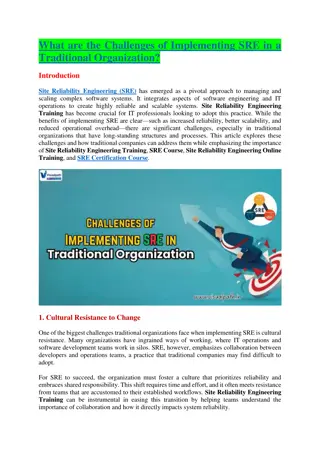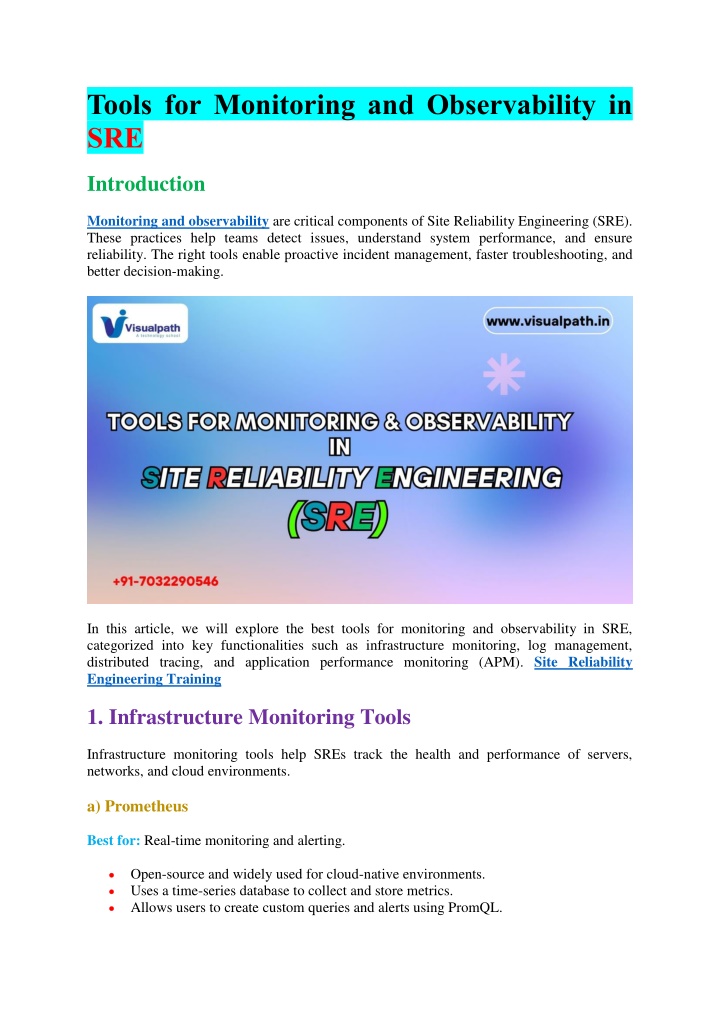
Site Reliability Engineering Online Training
VisualPath offers the best Site Reliability Engineering Course to master SRE tools like Prometheus, Grafana, and Ansible. Get expert-led, job-oriented training with real-time projects, hands-on practice, and 24/7 access. Enjoy daily recorded classes
Uploaded on | 1 Views
Download Presentation

Please find below an Image/Link to download the presentation.
The content on the website is provided AS IS for your information and personal use only. It may not be sold, licensed, or shared on other websites without obtaining consent from the author. If you encounter any issues during the download, it is possible that the publisher has removed the file from their server.
You are allowed to download the files provided on this website for personal or commercial use, subject to the condition that they are used lawfully. All files are the property of their respective owners.
The content on the website is provided AS IS for your information and personal use only. It may not be sold, licensed, or shared on other websites without obtaining consent from the author.
E N D
Presentation Transcript
Tools for Monitoring and Observability in SRE Introduction Monitoring and observability are critical components of Site Reliability Engineering (SRE). These practices help teams detect issues, understand system performance, and ensure reliability. The right tools enable proactive incident management, faster troubleshooting, and better decision-making. In this article, we will explore the best tools for monitoring and observability in SRE, categorized into key functionalities such as infrastructure monitoring, log management, distributed tracing, and application performance monitoring (APM). Site Reliability Engineering Training 1. Infrastructure Monitoring Tools Infrastructure monitoring tools help SREs track the health and performance of servers, networks, and cloud environments. a) Prometheus Best for: Real-time monitoring and alerting. Open-source and widely used for cloud-native environments. Uses a time-series database to collect and store metrics. Allows users to create custom queries and alerts using PromQL.
Integrates well with Kubernetes, Docker, and other containerized systems. b) Nagios Best for: Monitoring networks, applications, and system performance. SRE Course Provides extensive monitoring capabilities for infrastructure and services. Can detect outages and send real-time alerts. Supports custom plugins for extending functionality. Requires manual configuration, which may be complex for beginners. c) Zabbix Best for: Enterprise-level IT infrastructure monitoring. Open-source with a web-based dashboard. Supports both agent-based and agentless monitoring. Can monitor CPU, memory, disk usage, and network traffic. Provides predictive analytics for trend analysis. 2. Log Management and Analysis Tools Log management is essential for troubleshooting issues, security auditing, and understanding system behavior. Site Reliability Engineering Online Training a) ELK Stack (Elasticsearch, Logstash, Kibana) Best for: Centralized log collection and visualization. Elasticsearch enables fast searching of logs. Logstash collects and processes log data from different sources. Kibana provides visualization dashboards for analysis. Scales well for enterprise-level log management. b) Splunk Best for: Real-time log analysis and security monitoring. Enterprise-grade log analysis tool with AI-driven insights. Supports advanced search queries and custom dashboards. Provides alerts based on anomaly detection. Can be expensive for small teams but highly powerful. c) Graylog Best for: Cost-effective log management. Open-source log management tool. Provides real-time log collection and analysis.
Supports custom alerting and dashboards. Requires additional setup compared to commercial solutions. 3. Distributed Tracing Tools Tracing tools help track requests as they travel through different microservices, making them essential for debugging performance issues. a) Jaeger Best for: Tracing distributed applications in a microservices architecture. Developed by Uber and open-source. Helps identify bottlenecks and latency issues. Provides end-to-end request tracking. Integrates well with Kubernetes and OpenTelemetry. b) OpenTelemetry Best for: Standardized observability across multiple platforms. Open-source project backed by the Cloud Native Computing Foundation (CNCF). Provides metrics, logs, and tracing in one framework. Compatible with Prometheus, Jaeger, and other observability tools. Supports auto-instrumentation for multiple languages. c) Zipkin Best for: Root cause analysis of performance issues. Developed by Twitter for tracing latency in microservices. Helps visualize the flow of requests in a system. Supports integration with Prometheus and Grafana. Not as feature-rich as Jaeger but lightweight and efficient. 4. Application Performance Monitoring (APM) Tools APM tools help ensure application reliability by tracking errors, performance, and user interactions. a) New Relic Best for: Full-stack observability with AI-powered insights. Provides detailed application performance metrics. Offers real-time monitoring and anomaly detection. Supports cloud-native and hybrid environments. Can be costly for large-scale deployments.
b) Datadog Best for: Comprehensive monitoring across cloud environments. Offers infrastructure, APM, and security monitoring. Provides real-time dashboards and alerts. Supports integrations with AWS, Azure, and Kubernetes. Ideal for DevOps and SRE teams handling large-scale applications. c) AppDynamics Best for: Enterprise-grade APM with AI-driven automation. Owned by Cisco and optimized for business-critical applications. Provides end-to-end visibility into performance issues. Helps correlate application issues with business impact. Supports automated root cause analysis. 5. Synthetic Monitoring Tools Synthetic monitoring tools simulate user interactions with applications to detect potential issues before they impact real users. SRE Training Online a) Pingdom Best for: Website and API uptime monitoring. Provides alerts for downtime and performance issues. Tracks page speed and user experience metrics. Integrates with incident management tools like PagerDuty. b) ThousandEyes Best for: Network performance and digital experience monitoring. Helps identify performance bottlenecks across networks. Provides deep insights into cloud and SaaS applications. Useful for detecting ISP-related outages. c) Site24x7 Best for: Cloud and infrastructure monitoring. Provides synthetic monitoring for applications and APIs. Offers real-time alerts for performance degradation. Supports network and cloud-based infrastructure monitoring. 6. Incident Management and Alerting Tools
Incident management tools help teams respond to issues efficiently and minimize downtime. a) PagerDuty Best for: Automated incident response. Provides on-call scheduling and real-time alerts. Integrates with monitoring tools like Prometheus, Datadog, and New Relic. Helps teams automate incident resolution. b) Opsgenie Best for: Centralized alerting and collaboration. Owned by Atlassian and integrates with Jira. Supports on-call rotation scheduling. Helps streamline incident workflows for SRE teams. c) VictorOps (Splunk On-Call) Best for: DevOps and SRE incident collaboration. SRE Courses Online Provides intelligent alert routing and escalation. Supports team-based collaboration during incidents. Integrates with monitoring tools like Prometheus and Nagios. Conclusion Monitoring and observability are crucial to SRE practices, enabling teams to maintain system reliability and resolve issues promptly. The best tools depend on the specific needs of an organization, whether it involves infrastructure monitoring, log management, distributed tracing, application performance management (APM), or incident management. For a robust observability strategy, SRE teams should consider a combination of: Prometheus for infrastructure monitoring. ELK Stack for log management. Jaeger or OpenTelemetry for distributed tracing. Datadog or New Relic for application performance monitoring. PagerDuty or Opsgenie for incident response. By integrating these tools, teams can enhance visibility, reduce downtime, and ensure a seamless user experience. Trending Courses: ServiceNow, Docker and Kubernetes, SAP Ariba Visualpath is the Best Software Online Training Institute in Hyderabad. Avail is complete worldwide. You will get the best course at an affordable cost. For More
Information about Site Reliability Engineering (SRE) training Contact Call/WhatsApp: +91-7032290546 Visit: https://www.visualpath.in/online-site-reliability- engineering-training.html

